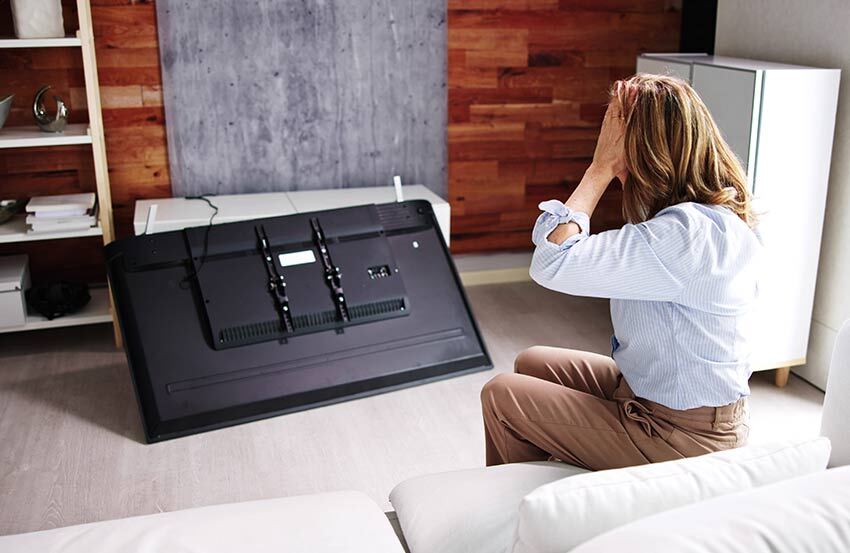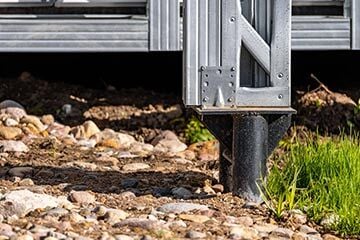TVs are a major centrepiece of homes up and down the UK - what else would we point our furniture at? But it's easy to forget how important they are when you're watching the latest drama series or a big sports match.
Your home contents insurance might already cover your TV, but there are limits. We explain all in this guide.

Is TV insurance included as part of my contents insurance policy?
Yes! Your television should typically be covered by your home insurance - specifically your contents insurance, if you have it.
This should offer you protection against unexpected damage and loss, or if your TV is stolen.
To ensure your big screen is completely protected, you'll need to check over your policy, as there are common exclusions. These typically include:
- General wear and tear
- Accidental damage
- Pre-existing damage
- If your property is left unoccupied for longer that a stated length of time
- High-value items that exceed the single-item limit
You can get cover for some of these exclusions though! You can buy accidental damage cover as an added extra and increase your contents insurance single-item limit.
Do I need insurance for my TV?
It depends on what protection you want for your TV. Ask yourself, would you be comfortable paying to repair or replace your TV if it's lost, stolen or damaged? Do you have an existing home contents insurance policy? Are you concerned about mechanical breakdowns?
Chances are, if you have a contents insurance policy, you'll already have a form of cover you may not be aware of!
You also need to look out for any manufacturer warranty, this is sometimes included as standard when you buy a TV.
This usually covers you for any technical defects or necessary repairs for the duration of the warranty. Some manufacturers offer extended warranties, others could offer them for an additional cost. Most standard warranties last up to a year.
Broader cover can be found through standalone TV insurance policies. These policies can bridge the gap if you're concerned about breakdowns, accidental damage or have an expensive TV.
Essentially, a contents insurance policy can cover your TV to a degree. You still have the option of buying further cover to broaden your contents insurance policy. Or you could look at a dedicated standalone policy.
Whatever you decide to do, just make sure you're not paying for 2 lots of insurance cover for your TV!
What level of cover can I get for my television?
There are a few ways to ensure your TV is covered. It's in your court to decide what type of insurance is best for your needs, so we'll talk you through each!
First up, let's talk about what cover you typically have included with a home contents insurance policy. The good news is that you might already have this type of home insurance.
It'll cover you against sudden or unexpected events causing damage or loss. This could be fire damage to your home, storms, flooding, theft and more.
There are common exclusions with this type of policy, like we mentioned earlier. Accidental damage and items over a single-item limit are good examples of this. You can always buy these optional extras to enhance your policy.
If you want broader protection, you could look at a standalone TV insurance policy.
These policies can include a wider range or cover, including electrical and mechanical breakdowns. As these policies are dedicated for your TV or home appliances, you can find insurance with increased cover amounts.
If you prefer this type of insurance, it just means that you'll have to pay for another policy in addition to home insurance.
Some TV insurance policies also extend your manufacturer warranty. This is worth bearing in mind, as it's unlikely a home contents insurance policy can offer the same.
What damage am I covered against?
We discussed how sudden and unexpected events are covered by a contents insurance policy. This includes:
- Theft
- Flooding (including burst pipes and water damage)
- Fire
- Storm damage
Accidental damage cover isn't normally included with a contents insurance policy. You can always buy this to enhance your cover for an extra cost.
Why could this be useful? If you accidentally drop your TV, and the screen cracks (we've all been there), you'll be covered if you need to repair or replace it.
If you opt for a standalone home appliance insurance policy, it could also offer mechanical and electrical breakdown cover.
As far as common exclusions go, there are a few. Insurers don't tend to offer cover for:
General wear and tear: Over time your television could suffer a few scratches, bumps and malfunctions along the way.
Appliances over a certain age: Electrical appliances have a shelf life, and TVs aren't an exception to the rule.
Contents left in an unoccupied home: It's fairly common for home contents insurance policies to exclude cover if you leave a property unoccupied for longer than a set period of time. Usually this is around 30 days.
Can I insure more than 1 TV in my home?
Absolutely. If you have multiple TVs, contents insurance shouldn't restrict you from claiming for 2 or more of the same item.
With that said, TVs may not be among the cheapest contents in your home. So you need to be aware of your total cover limit, especially if you're claiming for multiple TVs.
Is there a limit on the value of the TV that’s covered?
Usually, yes. The vast majority of insurance policies include single-item and total cover limits. But what do these mean?
Single-item cover limit: A home contents insurance policy typically includes a cap for any 1 item within your total cover limit. So, let's say you have a valuable watch worth £5,000, for example. If your single-item limit is set at £2,000, and you need to claim, your insurer won't pay out the difference.
A single-item limit tends to range from £1,000 to £2,500, but varies depending on your insurer. You could have the option of increasing your single-item limit, but this costs more.
Total cover limit: This refers to the maximum cover limit of your policy. It should be based on the total value of your contents, which is why it's important to accurately estimate this before buying a policy.
You can typically change your total cover amount based on your belongings. But, if you set a higher cover amount, you'll likely pay more for your contents insurance policy.
How do I make a claim for damage to my television?
If disaster strikes and you need to claim on your home insurance for your TV, you should reach out to your insurer as soon as you can. Some have 24-hour claims support and a dedicated contact number, but this varies depending on your insurer. Your policy documents should tell you how to make a claim.
To make a claim, you'll need your policy number to hand. You can make the claims process smoother by giving a detailed explanation of how your TV got damaged.
If you have evidence, even better. If you can, provide any copies of receipts and take photos of the damage. You should receive a crime reference number if your TV was stolen or if it was damaged by a break-in. You'll also need to give this to your insurer along with any other evidence.
There's no set timetable to settle a claim, this can take a couple of weeks or months depending on the claim itself and the surrounding circumstances.







